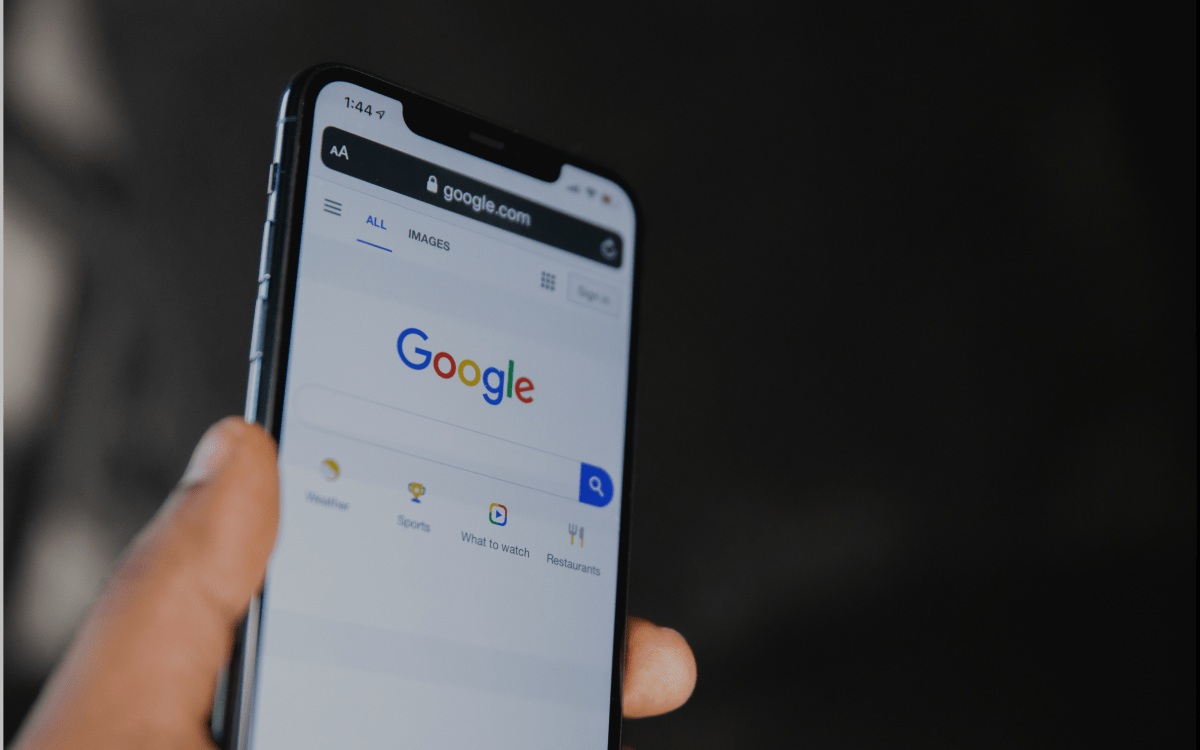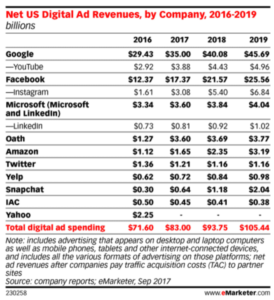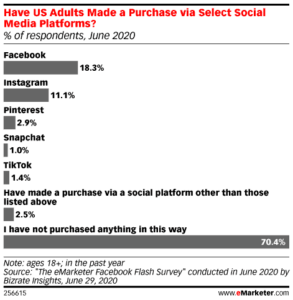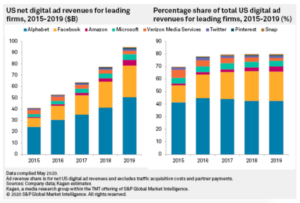
If you’ve ever run a digital marketing campaign, chances are you used Google Ads or Facebook to promote your business. Collectively, Google Ads and Facebook made up 60% of the U.S. digital ads market in 2019 and in spite of reports of advertisers abandoning Facebook both platforms will likely maintain their continued dominance for the foreseeable future.
Where once digital advertisers were overrun with choices for allocating their ad budgets, in 2021 the duopoly’s lack of choice can feel stifling. What does its dominance mean for digital marketers? Can we avoid two of the industry’s key players, or will we spend more years looking for ways to make these commanding platforms work for us?
Why Do Google and Facebook Dominate Digital Advertising?
The short answer is reach.
By some estimates, 90% of internet sessions begin with Google.
Facebook, in spite of recent reports of user loss, still logs 2.74 billion monthly active users on its platform. By comparison, Twitter, another tech company name brand, only counts 353 million monthly visitors.
In addition, users are far more likely to make a purchase from Facebook (and Instagram, which is owned by Facebook) than any other social media site.
Is Google and Facebook’s Dominance Bad for Marketers?
Like anything, it’s a double-edged sword. Google’s search dominance makes it the ideal platform to introduce your brand to people who don’t know what they’re looking for. But that same dominance means that advertising costs will increase at Google’s mercy, and though cost-per-click appears to have rebounded since the start of the pandemic, we predict it will rise as the economy recovers. What’s more, as Google seeks to grow revenues the search quality is declining, meaning that those brands that can afford to reach the top of the ad heap are pushing down organic results and smaller advertisers.
Facebook is another story. There’s mounting evidence that Facebook’s targeting is much poorer than it has led advertisers to believe, and a recent lawsuit claims that Facebook has used false reach metrics to overcharge advertisers for years.
Beyond Google Ads & Facebook: The Online Marketing Landscape in 2021
Google and Facebook may be the top two by a landslide, but other advertising platforms are gaining some ground. Amazon, advancing as a minor threat to the duopoly, recorded $11.33 billion in advertising for 2019 and grew again in 2020 with 51% year-over-year growth in the “other revenue” bucket that includes advertising earnings. Other players also had strong showings in 2020, including:
- SnapChat
- Tik Tok
S&P revealed some interesting growth into 2019 with marketing platforms outside of the duopoly gaining more revenue.
Despite the global pandemic upsetting some digital platforms in 2020, there was a general sense of recovery and even improvement for many platforms by the end of last year. Pinterest, for instance, reported record engagement in early 2020 as people sought out ways to stay busy and productive at home.
Advertising on Google & Facebook: Do We HAVE To?
Though Google and Facebook are clear industry leaders in advertising revenue, marketers don’t have to advertise through their platforms. However, the current state of the market is such that avoiding the two key players means working harder to identify your audience and zero in on the right places to connect. Marketers who don’t want to play in the duopoly will need to carefully consider the following when planning their campaigns:
Where else is your audience? B2B companies are likely to find key decision-makers on LinkedIn, while retail products can expect some success with Amazon. Products aimed at younger generations can explore Tik Tok or SnapChat for a relevant reach.
What do you need to make your advertising work? Google Ads offers the opportunity to use straight-forward text to get your message across. Other platforms may necessitate developing video, beautiful imagery, and even quirky messaging that will catch the eye of a Generation Z audience.
Can you afford to step away? Google and Facebook have the audiences. They have easy-to-use marketing platforms that reach the majority of the U.S. population. You can expect a certain level of performance for your ads while other platforms are less predictable.
Lack of choice is frustrating for marketers, but we do see some light at the end of the tunnel. Check back next week for the second part of this series, where we explore digital privacy concerns and how they have the potential to upset the digital advertising duopoly for good.
Share this post on your social profile:
A performance-driven marketing strategist with twenty years of experience growing international brands and organizations, Tim Young spent time at the Corporate Executive Board (now Gartner) and the Entrepreneurs' Organization before founding Young Marketing Consulting in 2013.
His areas of expertise include brand growth and identity development; lead generation and conversion; search engine optimization (SEO); customer satisfaction evaluation and improvement; customer segmentation and CRM work; ROI analysis and improvement; market research; and product development.
Want to get our blogs directly to your inbox?
Enter your email to sign up for our point of view on marketing trends, brand strategy, and sustainable business.





